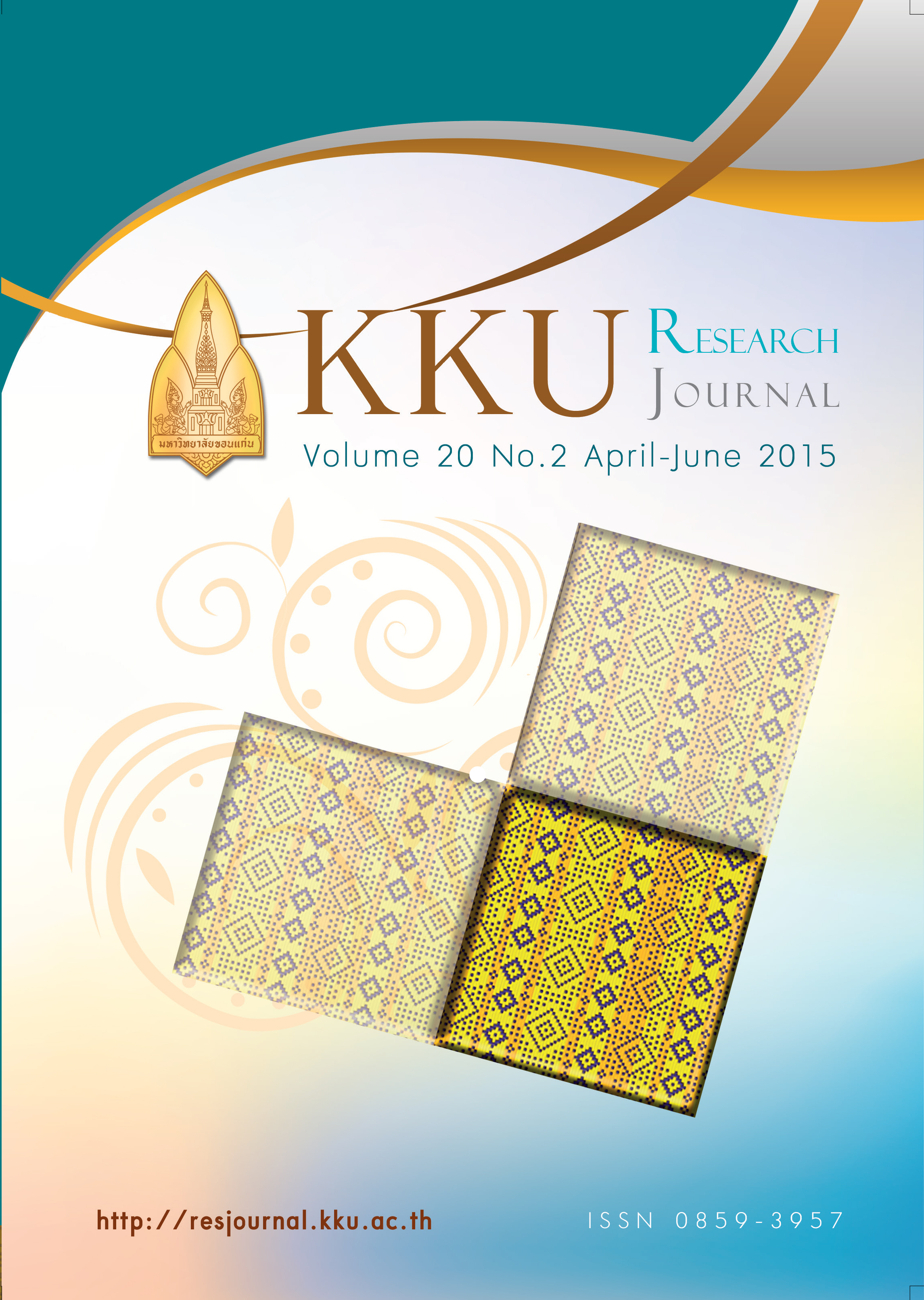High cell density cultivation for docosahexanoic acid production of Schizochytrium sp. BCC 25505
Main Article Content
Abstract
Docosahexanoic acid (22:6 n-3; DHA) is a polyunsaturated fatty acid that is essential for functional development and maintenance of human brain and is also involved in the prevention of cardiovascular diseases, improving neural and retinal development in infants. Schizochytriumsp. BCC 25505, a marine protist, can produce DHA at high yield.In this study, biomass and DHA production of this marine protist were carried out to avoid glucose repression and nitrogen limitation using high cell density cultivation technique. The use of high glucose concentration resulted in a slow growth rate and low biomass concentration. By employing central composite design and by pulsing 40 gL-1 glucose at a time yielded maximum biomass (77.3g.L-1) and DHA (18.5 gL-1) productions.Theoptimal conditions for maximizing DHA production of Schizochytrium sp. BCC 25505 calculated using Design expert software were validated in a 5L bioreactor cultivation, yielding at 97 h a maximum concentration of biomass and docosahexanoic acid of 70.8 and 14.1gL-1 respectively. This was further scaled up in 300 L bioreactor and 115.9 gL-1 biomass, 15.0 gL-1 DHA at 119 h were obtained. This optimal fermentation process can provide a low cost production of DHA, which can be used in industrial scale.
Article Details
References
[2] Bailey RB, DiMasi D, Hansen JMM, Mirrasoul PJ, Ruecker CM, Veeder III GT. Enhanced production of lipids containing polyenoic fatty acid by very high density cultures of eukaryotic microbes in fermenters. United States Patent 6,607,900. 2003.
[3] Bajpai P, Bajpai P, Ward OP. Production of docosahexanoic acid (DHA) by Thraustochytriumaureum. ApplMicrobiolBiotechnol. 1991a; 35:706-10.
[4] Bajpai P, Bajpai P, Ward OP.Optimisation of production of docosahexanoic acid (DHA) by ThraustochytriumaureumATCC 34304. J Am Oil Chem Soc. 1991b; 68:509-14.
[5] Bowles RD, Hunt AE, Bremer GB, Duchars MG, Eaton RA. Longchain n-3 polyunsaturated fatty acid production by members of the marine protistan group the thraustochytrids: screening of isolates and optimization of docosahexanoic acid production. J Biotechnol. 1999;70:193-202.
[6] Connor WE, Neuringer M, Reisbick S. Essential fatty acid: the importance of n-3 fatty acids in the retina and brain. Nutr Rev. 1992;50:21-29
[7] Das UN, Fams MD. Long-chain polyunsaturated fatty acids in the growth and development of the brain and memory. Nutr. 2003;19:62-65.
[8] deSwaaf ME, deRijk TC, Eggink G, Sijtsma L. Optimisation of docosahexanoic acid production in batch cultivations by Crypthecod-iniumcohnii. J Biotechnol. 1999;70:185-92.
[9] deSwaaf ME, Pronk JT, Sijtsma L. (2003) Fed-batch culture of the docosahexanoic-acid-producing marine alga Crypthecodiniumcohniion ethanol. ApplMicrobiolBiotechnol. 2003;61:40–43.
[10] Fan KW, Chen F, Jones EBG, Vrijmoed LLP. Eicosapentaenoic and docosahexanoic acids production by and okara-utilizing potential of thraustochytrids. J IndMicrobiolBiotechnol. 2001;27:199-202.
[11] Horrocks LA, Yeo YK. Health benefits of docosahexanoic acid (DHA). Pharmacol Res. 1999;40:211-225.
[12] Kim K,Kim EJ, Ryu BG, Park S, Yang YC. A novel fed-batch process based on the biology of Aurantiochytrium sp.KRS101 for the production of biodiesel and docosahexaenoic acid.Bioresou Technol. 2013; 135: 269-274.
[13] Kyle DJ. Microbial oil mixtures and uses thereof. United States Patent 5,374,657. 1994.
[14] Kyle DJ. Arachidonic acid and methods for the production and use thereof. United States Patent 5,658,767. 1997.
[15] Miller MR, Nichols PD, Carter CG. Replacement of fish oil with thraustochytridSchizochytriumsp. L oil in Atlantic salmon parr (Salmosalar L) diets. CompBiochem Physiol. 2007;148:382-392.
[16] Nordoy AR, Marchioli R, Amesen H, Videbaek J. n-3 polyunsaturated fatty acids and cardiovascular diseases. Lipids. 2001;36:127-129.
[17] Qu L, Ren LJ, Sun GN, Ji XJ, Nie ZK, Huang H. Batch, fed-batch and repeated fed-batch fermentation processes of the marine thraustoch-ytridSchizochytrium sp. for producing docosahexaenoic acid. Bioprocbiosysteng. 2013; 1-8.(18)Ratledge C. Regulation of lipid accumulation in oleaginous micro-organisms. BiochemSoc Trans. 2002;30:1047-1050.
[19] Ratledge C, Wynn JP. The biochemistry and molecular biology of lipid accumulation in oleaginous microorganisms. AdvApplMicro-biol. 2002;51:1-5.
[20] Simopoulos AP, Leaf A, Salem JrN. Essentiality of and recommended-dietary intakes for omega-6 and omega-3 fatty acids. Ann NutrMetab. 1999a;43:127-130.
[21] Simopoulos AP, Leaf A, Salem JrN. Workshop on the essentiality of and recommended dietary intakes for omega-6 and omega-3 fatty acids. Food Aust. 1999b;5:332-333.
[22] Singh A, Ward OP. Production of high yields of docosahexanoic acid by ThraustochytriumroseumATCC 28210. J IndMicrobiol. 1996;16:370-373.
[23] Singh A, Ward OP. Microbial Production of Docosahexanoic Acid (DHA, C22:6). AdvApplMi-crobiol. 1997;45:271-312.
[24] Unagul P, Assantachai C, Phadun-gruengluij S, Suphantharika M, Tanticharoen M, Verduyn C. Coconut water as a medium additive for the production of docosahexanoic acid [C22:6 n3) by Schizochytrium mangroveiSk-02. Bioresour Tech. 2007;98:281-287.
[25] Ward OP, Singh A (2005) Omega-3/6 fatty acids: Alternative sources of production. Process Biochem. 2005;40:3627-3652.
[26] Wu ST, Yu ST, Lin EC. Effect of culture conditions on docosahexae-noic acid production by Schizochy-trium sp. S31. Process Biochem. 2005;40:3103-3108.
[27] Yan J, Cheng R, Lin X, Li SYK, Rong H, Ma Y. Overexpression of acetyl-CoA synthetase increased the biomass and fatty acid propor-tion in microalgaSchizochytri-um. Applmicrobiolbiotechnol. 2013; 1-7.
[28] Yokochi T, Honda D, Higashihara T, Nakahara T. Optimization of docosahexanoic acid production by SchozochytriumlimacinumSR21. ApplMicrobiolBiotechnol. 1998;49:72-76.
[29] Zhang Y, Arends JBA, Van de Wiele T, Boon N. Bioreactor technology in marine microbiology: From design to future application. Biotechnol Adv. 2011; 29:312–321.
[30] Zhu L, Zhang X, Ren X, Zhu Q. Effect of culture conditions on growth and docosahexanoic acid production from Schizochytriumli-macinum. J Ocean Univ Chin. 2008; 7:83-88.


